Oil Cleanup
-
- Open Committee On CG Oil Spill Legislation Completes 1 st Phase Maritime Reporter, May 1992 #58
The initial phase of the Coast Guard's first attempt at developing legislation with the assistance of direct public input is completed.
In an attempt to formulate a fair and reasonable set of regulations pertaining to the Oil Spill Act of 1990, the Coast Guard formed a 28 member committee to provide recommendations to be incorporated into a Notice of Proposed Rulemaking (NPRM). When published in early May, the NPRM will touch on such topics as tank vessel pollution response plans, the carriage of response equipment aboard tank vessels and the certification of oil cleanup contractors. The committee will reconvene after the close of the NPRM comment period to assist the Coast Guard in drafting the final rule.
The negotiated rulemaking committee consisted of representatives from environmental and public interest groups, spill response contractors, tank vessel owners and operators, cargo interests, oil handling facilities and state and local governments.
Pleased with the results of the negotiated process, Rear Adm.
Arthur E. Henn, chief of the Coast Guard's office of marine safety, security and environmental protection, said "your efforts produced a far better regulation than if we had tried the traditional notice and comment method of rulemaking." The Coast Guard would like to see negotiated rulemaking used in future cases where users are able to provide a valuable insight to the process.
-
- Gulf's Oil Recovery Vessel For Bantry Bay, Ireland Built In Rhode Island By Blount Marine Maritime Reporter, May 15, 1977 #46
at speeds up to 9 knots and to recover oil up to 3 knots. The vessel, custom built for Gulf Oil use, is the prototype of a deepwater class of oil cleanup vessels that use a skimmer principal developed by JBF Scientific Corporation in Wilmington, Mass. Built by Blount Marine Corporation, Warren
-
- MN 100: Elastec Marine News, Aug 2015 #27
revolutionary offshore oil spill recovery system: ELASTEC X150 Skimmer Launching System. Notably, the company won the X Prize Foundation’s Wendy Schmidt Oil Cleanup X CHALLENGE with its patented grooved disc oil skimming technology. Beyond this, the company was also instrumental in managing the controlled burn
-
- MN100: Elastec Marine News, Aug 2016 #26
systems were deployed in the controlled burn operation during the Deepwater Horizon incident in the Gulf of Mexico. Elastec won the Wendy Schmidt Oil Cleanup X CHALLENGE with its patented Grooved Disc Skimming technology. 926 County Road 1350 N Carmi, IL 62821 Telephone: (618) 384-2783 E-mail:
-
- X (Prize) Marks the Spot Marine Technology, Mar 2014 #52
a number of scientific fields. The group has previously held competitions targeting advances in personalized medicine, automotive fuel efficiency, oil cleanup and privatized space exploration, to name a few. For its latest competition, XPRIZE has partnered with the Wendy Schmidt Foundation to launch the
-
- Alaska Pipeline Background Information -Tankers Required To Cost $1.6 Billion Maritime Reporter, Mar 1974 #14
will use steel mechanical arms rather than hoses. Tankers will have on-board controls to prevent overfilling tanks in loading or discharge. 'New oil cleanup equipment and methods will be on standby. 'Both water and foam fire-ifighting equipment will be on hand. Ships will have separate ballast tanks
-
- A Turning Point in Oil Spill Recovery Marine News, Oct 2017 #40
Prize Foundation also saw the need for an improvement in mechanical oil spill recovery in the aftermath of the disaster and developed the Wendy Schmidt Oil Cleanup X CHALLENGE with a one million dollar first place prize. The Challenge was “designed to inspire a new generation of innovative solutions that will
-
- Marine Salvage & Oil Spill Response Insights Maritime Reporter, Mar 2015 #54
exist for the recovery of sinking oils. This is not really a new or challenging issue, but one that does kind of cross the bounds from typical oil cleanup operations Elliot Bottom line: Whether the oil floats or sinks, the salvor should be the first call to keep the oil inside the ship or to safely
-
- DIESEL POWER REVIEW Maritime Reporter, Jul 1990 #20
delivery by B&H Metal Products, Lewiston, Idaho, the bowramp, shallow-draft vessel was immediately hired by Exxon for the Exxon Valdez oil cleanup effort. Coast Guard certified to carry 49 passengers, the Lucinda Rose ferried beach cleanup crews until the spill cleanup effort was discontinued l
-
 )
March 2024 - Marine Technology Reporter page: 42
)
March 2024 - Marine Technology Reporter page: 42versions Image courtesy Kongsberg Discovery are featured in the series, and all withstand reverse pressure, too, and can be installed into both dry and oil-? lled canisters. MacArtney introduced a space and weight-saving ø12.7 mm SubConn Nano, a Nano connector which offers a versatile and robust performance
-
 )
March 2024 - Marine Technology Reporter page: 39
)
March 2024 - Marine Technology Reporter page: 397 A 35Ah AGM lead-acid battery is tested using the West Mountain Radio CBA to show the effect of simply ? lling the battery voids with mineral oil as a compensating ? uid. The CBA is programmed to cut-off at a voltage of 10.50v. The top line (red) shows the unmodi? ed AGM battery capacity of
-
 )
March 2024 - Marine Technology Reporter page: 36
)
March 2024 - Marine Technology Reporter page: 36, Thus, there are no implodable spaces, and so are candidate and UPS, have speci? c guidelines available on their websites. cells for pressure-balanced, oil-? lled (PBOF) assemblies. This author has personally tested pouch LiPos to 20,000 psi im- Lead-Acid: The venerable lead-acid battery comes in three
-
 )
March 2024 - Marine Technology Reporter page: 35
)
March 2024 - Marine Technology Reporter page: 35.com/BPD.htm). have been tested ? Alkaline (alkaline-manganese dioxide): These prima- ry cells are available in the widest number of standard sizes, in oil-? lled bags and are commonly available around the world. This is handy to pressures of 20,000psi without if you are in a remote port and need
-
 )
March 2024 - Marine Technology Reporter page: 33
)
March 2024 - Marine Technology Reporter page: 33in the world.” How- ever, commercial success depends on many factors, not least a predictable OPEX. Over the past four years, SMD has worked with Oil States Industries to calculate cost per tonne ? gures for prospective customers. Patania II uses jet water pumps to Oil States’ Merlin riser systems
-
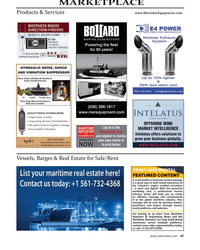 )
April 2024 - Maritime Reporter and Engineering News page: 47
)
April 2024 - Maritime Reporter and Engineering News page: 47.com Powering the fleet for 60 years! HYDRAULIC NOISE, SHOCK AND VIBRATION SUPPRESSOR Noise, Shock, VibraO on & PulsaO on in Quiet, Smooth Flow Out Oil Bladder Nitrogen (blue) Manufactured by MER Equipment Three Stage Noise & PulsaO on in ReducO on Chamber (206) 286-1817 www.merequipment.com QUALITY
-
 )
April 2024 - Maritime Reporter and Engineering News page: 41
)
April 2024 - Maritime Reporter and Engineering News page: 41maritime environments: • GMDSS/NAVTEX/NAVDAT coastal surveillance and transmission systems • Offshore NDB non-directional radio beacon systems for oil platform, support vessel & wind farm applications • DGPS coastal differential global positioning systems • VHF port communication systems Nautel
-
 )
April 2024 - Maritime Reporter and Engineering News page: 38
)
April 2024 - Maritime Reporter and Engineering News page: 38, including collecting MARPOL liquid The tanker vessel Archangel, 274 meters long and 85,474 and solid waste, transporting personnel and provisions, and oil gt, was moored using the 3-ton pulling capacity of the moor- spill response services. Images courtesy Consulmar Crowley's New LNG Containerships Carbon
-
 )
April 2024 - Maritime Reporter and Engineering News page: 35
)
April 2024 - Maritime Reporter and Engineering News page: 35becoming as interconnected as onboard sys- size training materials, including micro-learning videos, gam- tems. Kongsberg Digital has integrated NORBIT’s oil spill ing apps, VR programs and online mentoring. detection system with its K-Pos DP system for simulation- “These digital methods are more effective
-
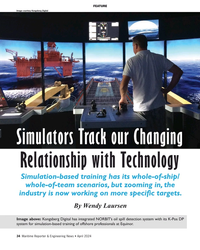 )
April 2024 - Maritime Reporter and Engineering News page: 34
)
April 2024 - Maritime Reporter and Engineering News page: 34scenarios, but zooming in, the industry is now working on more speci? c targets. By Wendy Laursen Image above: Kongsberg Digital has integrated NORBIT’s oil spill detection system with its K-Pos DP system for simulation-based training of offshore professionals at Equinor. 34 Maritime Reporter & Engineering
-
 )
April 2024 - Maritime Reporter and Engineering News page: 32
)
April 2024 - Maritime Reporter and Engineering News page: 32? xed wind. The subsidies won’t be a plentiful, and then a second on a luf? ng jib. This reduces the time it would there won’t be the same downturn in oil and gas that made all ordinarily take, weeks, to recon? gure the wiring of an ordi- the high-spec construction vessels available at attractive rates
-
 )
April 2024 - Maritime Reporter and Engineering News page: 25
)
April 2024 - Maritime Reporter and Engineering News page: 25vessels can MSC will see up to 20 new ships deliver to carry the equivalent of 30 C-17 transports. the ? eet in the next ? ve years. This includes new oil- Our Combat Logistics Force (CLF) is the key to keep- ing our ships at sea and in the ? ght, and sustain our forces ers, towing, salvage and rescue
-
 )
April 2024 - Maritime Reporter and Engineering News page: 21
)
April 2024 - Maritime Reporter and Engineering News page: 21along with our continued support to the in a UK design ? rm working in the North Sea marine industry,” said Langford. “We continue to hire key in- oil and gas platforms, the holy grail of rigorous dividuals and partner to provide best-in-class solutions.” R conditions in offshore energy production
-
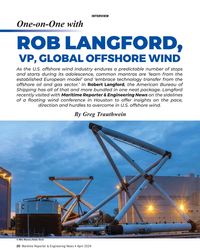 )
April 2024 - Maritime Reporter and Engineering News page: 20
)
April 2024 - Maritime Reporter and Engineering News page: 20and starts during its adolescence, common mantras are ‘learn from the established European model’ and ‘embrace technology transfer from the offshore oil and gas sector.’ In Robert Langford, the American Bureau of Shipping has all of that and more bundled in one neat package. Langford recently visited
-
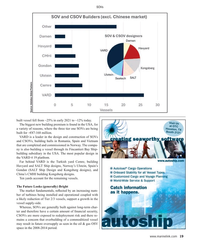 )
April 2024 - Maritime Reporter and Engineering News page: 19
)
April 2024 - Maritime Reporter and Engineering News page: 19more exposed to redeployment risk and there re- mains a concern that overbuilding of a commoditized vessel may result in future oversupply as seen in the oil & gas OSV space in the 2008-2014 period. www.marinelink.com 19 MR #4 (18-33).indd 19 4/5/2024 8:13:37 A
-
 )
April 2024 - Maritime Reporter and Engineering News page: 18
)
April 2024 - Maritime Reporter and Engineering News page: 18through dual fuel near shore Taiwanese market, which is also actively served by engines and (space for) a bunkering system. Currently metha- CTVs. Oil & gas offshore support vessels have been widely nol is a preferred energy carrier although hydrogen and liquid deployed to support construction logistics
-
 )
April 2024 - Maritime Reporter and Engineering News page: 17
)
April 2024 - Maritime Reporter and Engineering News page: 17or under construction in the North Euro- pean wind segment. Tier 2 and Tier 3 walk-to-work (W2W) vessels are cur- rently active in the segment, but as oil www.marinelink.com 17 MR #4 (1-17).indd 17 4/5/2024 8:40:33 A
-
 )
April 2024 - Maritime Reporter and Engineering News page: 16
)
April 2024 - Maritime Reporter and Engineering News page: 16charter to a wind turbine OEM or offshore wind in-built crane and gangway. farm operator to service and maintain equipment dur- ¦Tier 2: Generally, oil & gas tonnage (MPSVs, PSVs, ing the operations period of the wind farm. A typical etc.) with ? xed gangway, serving oil & gas and SOV will accommodat
-
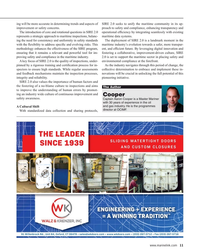 )
April 2024 - Maritime Reporter and Engineering News page: 11
)
April 2024 - Maritime Reporter and Engineering News page: 11wide culture of continuous improvement and Cooper safety awareness. Captain Aaron Cooper is a Master Mariner with 30 years of experience in the oil and gas industry. He is the programmes A Cultural Shift director at OCIMF. With standardized data collection and sharing protocols, THE LEADER SLIDING
-
 )
April 2024 - Maritime Reporter and Engineering News page: 10
)
April 2024 - Maritime Reporter and Engineering News page: 10users fully familiarize them- tion Report Program (SIRE 2.0). This initiative, led selves with the new regime, by using the portfolio of train- Tby the Oil Companies International Marine Forum ing materials and resources from OCIMF, has been key to (OCIMF), heralds a new era in vessel inspection, compliance
-
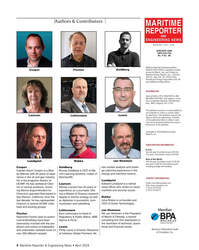 )
April 2024 - Maritime Reporter and Engineering News page: 4
)
April 2024 - Maritime Reporter and Engineering News page: 4is CEO of Ma- gic planning experience in the ter Mariner with 30 years of expe- rine Learning Systems, maker of energy and maritime sectors. rience in the oil and gas industry. MarineLMS. CONTACT INFORMATION: He is the programs director at Lundquist Email: [email protected] OCIMF. He has worked at Chev-
-
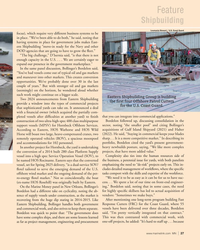 )
April 2024 - Marine News page: 27
)
April 2024 - Marine News page: 27to expand our presence in the government marketplace.” In the same panel discussion, Bollinger’s Bordelon said, “You’ve had vessels come out of typical oil and gas markets and maneuver into other markets. This creates conversion opportunities. We’ve probably done over 30 in the last couple of years.”
-
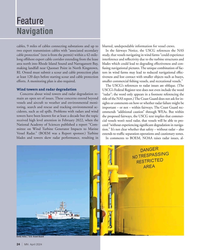 )
April 2024 - Marine News page: 24
)
April 2024 - Marine News page: 24radar failure might be toring, search and rescue and tracking environmental ac- important – or not – within fairways. The Coast Guard rec- cidents, such as oil spills. Problems with radars and wind ommends “additional caution” through WEAs. But within towers have been known for at least a decade but the topic
-
![MR Feb-24#39 , ignition, safety, pilot-oil
people that will be] working](https://images.marinelink.com/images/magazines/w200h250c/MaritimeReporter-202402-page41.png) )
February 2024 - Maritime Reporter and Engineering News page: 39
)
February 2024 - Maritime Reporter and Engineering News page: 39a testing program that will the fact that container ports are close to cities, and [all of the study aspects such as heat-release, ignition, safety, pilot-oil people that will be] working on board the vessel. We need to energy fraction, NOx and N2O emissions.” make sure that everybody's safe,” said Brindley
